Analyzing Recruitment, Selection, and Training at Nestle
VerifiedAdded on 2020/10/23
|24
|4131
|172
Report
AI Summary
This report analyzes the recruitment, selection, and training methods employed by Nestle, a multinational food and beverage company. The research aims to examine these processes and their impact on employee skills and organizational performance. The report includes an introduction outlining the aims and objectives, followed by a project management plan detailing costs, resources, quality, risks, and communication strategies. The research methodology section describes the qualitative research type, inductive approach, and descriptive research design used. Sampling involved 15 employees, and data was collected through primary sources. Data analysis involved thematic analysis. The report also addresses ethical considerations. The findings are presented through data analysis and discussion, focusing on recruitment sources. The report concludes with recommendations and a reflection on the research process, supported by references and an appendix.
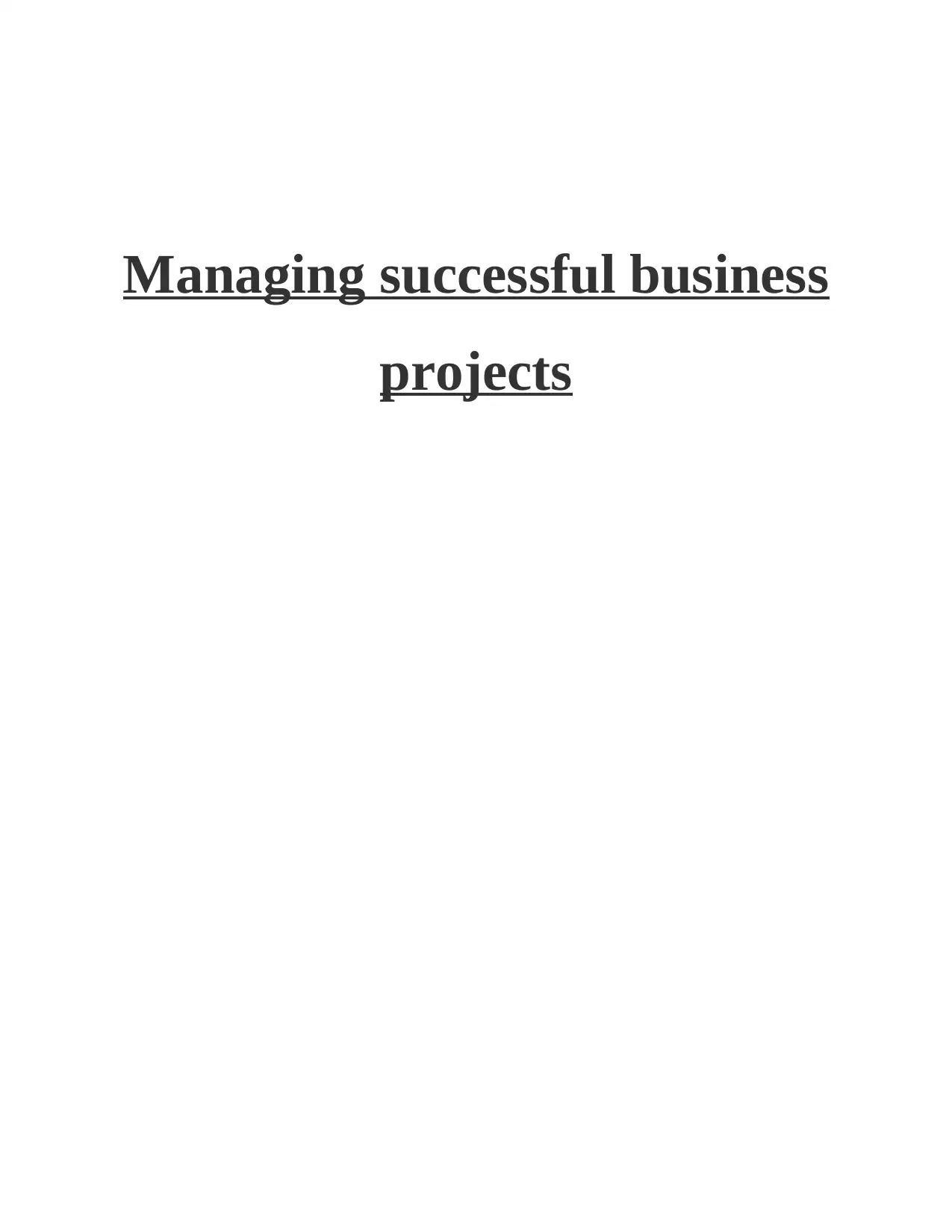
Managing successful business
projects
projects
Paraphrase This Document
Need a fresh take? Get an instant paraphrase of this document with our AI Paraphraser
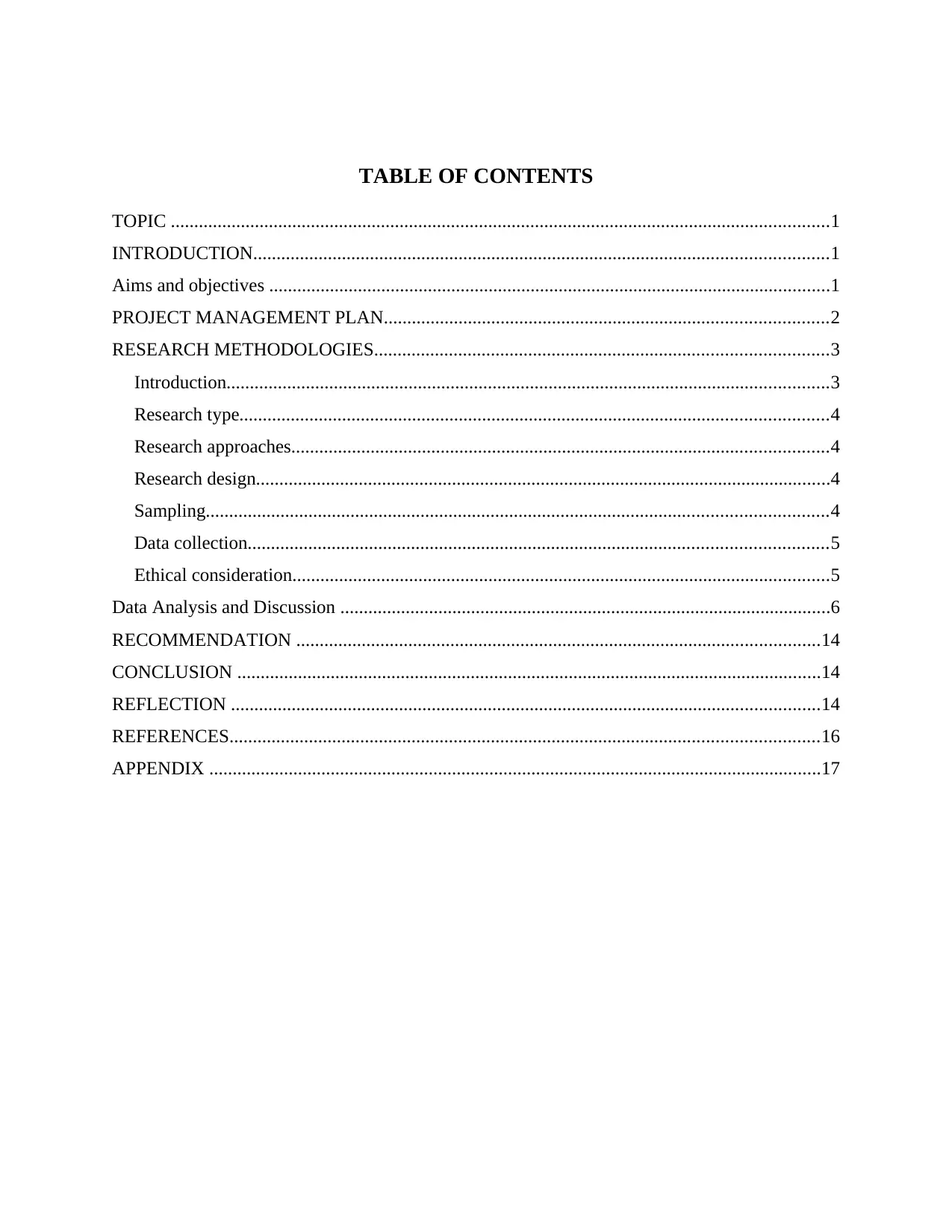
TABLE OF CONTENTS
TOPIC .............................................................................................................................................1
INTRODUCTION...........................................................................................................................1
Aims and objectives ........................................................................................................................1
PROJECT MANAGEMENT PLAN...............................................................................................2
RESEARCH METHODOLOGIES.................................................................................................3
Introduction.................................................................................................................................3
Research type..............................................................................................................................4
Research approaches...................................................................................................................4
Research design...........................................................................................................................4
Sampling.....................................................................................................................................4
Data collection............................................................................................................................5
Ethical consideration...................................................................................................................5
Data Analysis and Discussion .........................................................................................................6
RECOMMENDATION ................................................................................................................14
CONCLUSION .............................................................................................................................14
REFLECTION ..............................................................................................................................14
REFERENCES..............................................................................................................................16
APPENDIX ...................................................................................................................................17
TOPIC .............................................................................................................................................1
INTRODUCTION...........................................................................................................................1
Aims and objectives ........................................................................................................................1
PROJECT MANAGEMENT PLAN...............................................................................................2
RESEARCH METHODOLOGIES.................................................................................................3
Introduction.................................................................................................................................3
Research type..............................................................................................................................4
Research approaches...................................................................................................................4
Research design...........................................................................................................................4
Sampling.....................................................................................................................................4
Data collection............................................................................................................................5
Ethical consideration...................................................................................................................5
Data Analysis and Discussion .........................................................................................................6
RECOMMENDATION ................................................................................................................14
CONCLUSION .............................................................................................................................14
REFLECTION ..............................................................................................................................14
REFERENCES..............................................................................................................................16
APPENDIX ...................................................................................................................................17

⊘ This is a preview!⊘
Do you want full access?
Subscribe today to unlock all pages.

Trusted by 1+ million students worldwide
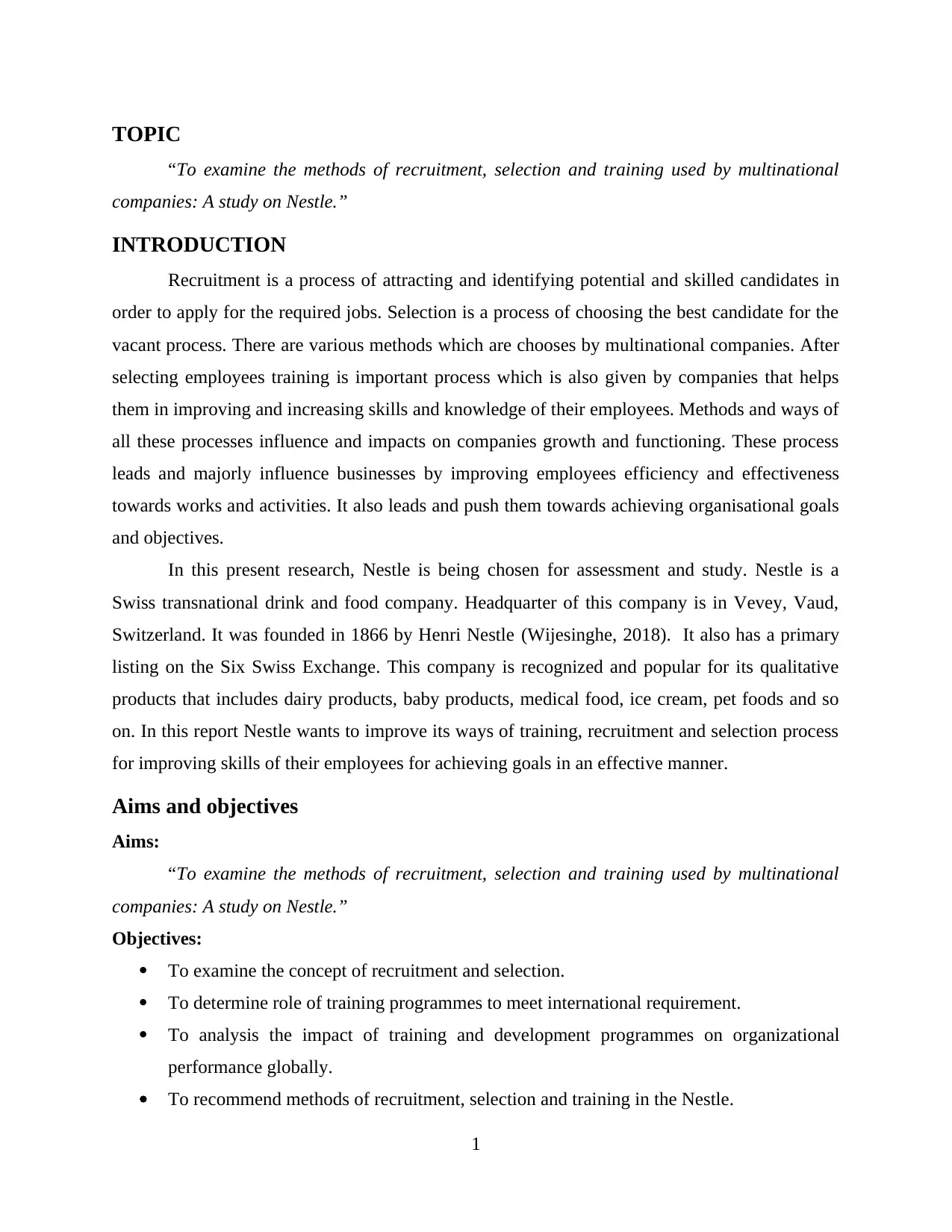
TOPIC
“To examine the methods of recruitment, selection and training used by multinational
companies: A study on Nestle.”
INTRODUCTION
Recruitment is a process of attracting and identifying potential and skilled candidates in
order to apply for the required jobs. Selection is a process of choosing the best candidate for the
vacant process. There are various methods which are chooses by multinational companies. After
selecting employees training is important process which is also given by companies that helps
them in improving and increasing skills and knowledge of their employees. Methods and ways of
all these processes influence and impacts on companies growth and functioning. These process
leads and majorly influence businesses by improving employees efficiency and effectiveness
towards works and activities. It also leads and push them towards achieving organisational goals
and objectives.
In this present research, Nestle is being chosen for assessment and study. Nestle is a
Swiss transnational drink and food company. Headquarter of this company is in Vevey, Vaud,
Switzerland. It was founded in 1866 by Henri Nestle (Wijesinghe, 2018). It also has a primary
listing on the Six Swiss Exchange. This company is recognized and popular for its qualitative
products that includes dairy products, baby products, medical food, ice cream, pet foods and so
on. In this report Nestle wants to improve its ways of training, recruitment and selection process
for improving skills of their employees for achieving goals in an effective manner.
Aims and objectives
Aims:
“To examine the methods of recruitment, selection and training used by multinational
companies: A study on Nestle.”
Objectives:
To examine the concept of recruitment and selection.
To determine role of training programmes to meet international requirement.
To analysis the impact of training and development programmes on organizational
performance globally.
To recommend methods of recruitment, selection and training in the Nestle.
1
“To examine the methods of recruitment, selection and training used by multinational
companies: A study on Nestle.”
INTRODUCTION
Recruitment is a process of attracting and identifying potential and skilled candidates in
order to apply for the required jobs. Selection is a process of choosing the best candidate for the
vacant process. There are various methods which are chooses by multinational companies. After
selecting employees training is important process which is also given by companies that helps
them in improving and increasing skills and knowledge of their employees. Methods and ways of
all these processes influence and impacts on companies growth and functioning. These process
leads and majorly influence businesses by improving employees efficiency and effectiveness
towards works and activities. It also leads and push them towards achieving organisational goals
and objectives.
In this present research, Nestle is being chosen for assessment and study. Nestle is a
Swiss transnational drink and food company. Headquarter of this company is in Vevey, Vaud,
Switzerland. It was founded in 1866 by Henri Nestle (Wijesinghe, 2018). It also has a primary
listing on the Six Swiss Exchange. This company is recognized and popular for its qualitative
products that includes dairy products, baby products, medical food, ice cream, pet foods and so
on. In this report Nestle wants to improve its ways of training, recruitment and selection process
for improving skills of their employees for achieving goals in an effective manner.
Aims and objectives
Aims:
“To examine the methods of recruitment, selection and training used by multinational
companies: A study on Nestle.”
Objectives:
To examine the concept of recruitment and selection.
To determine role of training programmes to meet international requirement.
To analysis the impact of training and development programmes on organizational
performance globally.
To recommend methods of recruitment, selection and training in the Nestle.
1
Paraphrase This Document
Need a fresh take? Get an instant paraphrase of this document with our AI Paraphraser
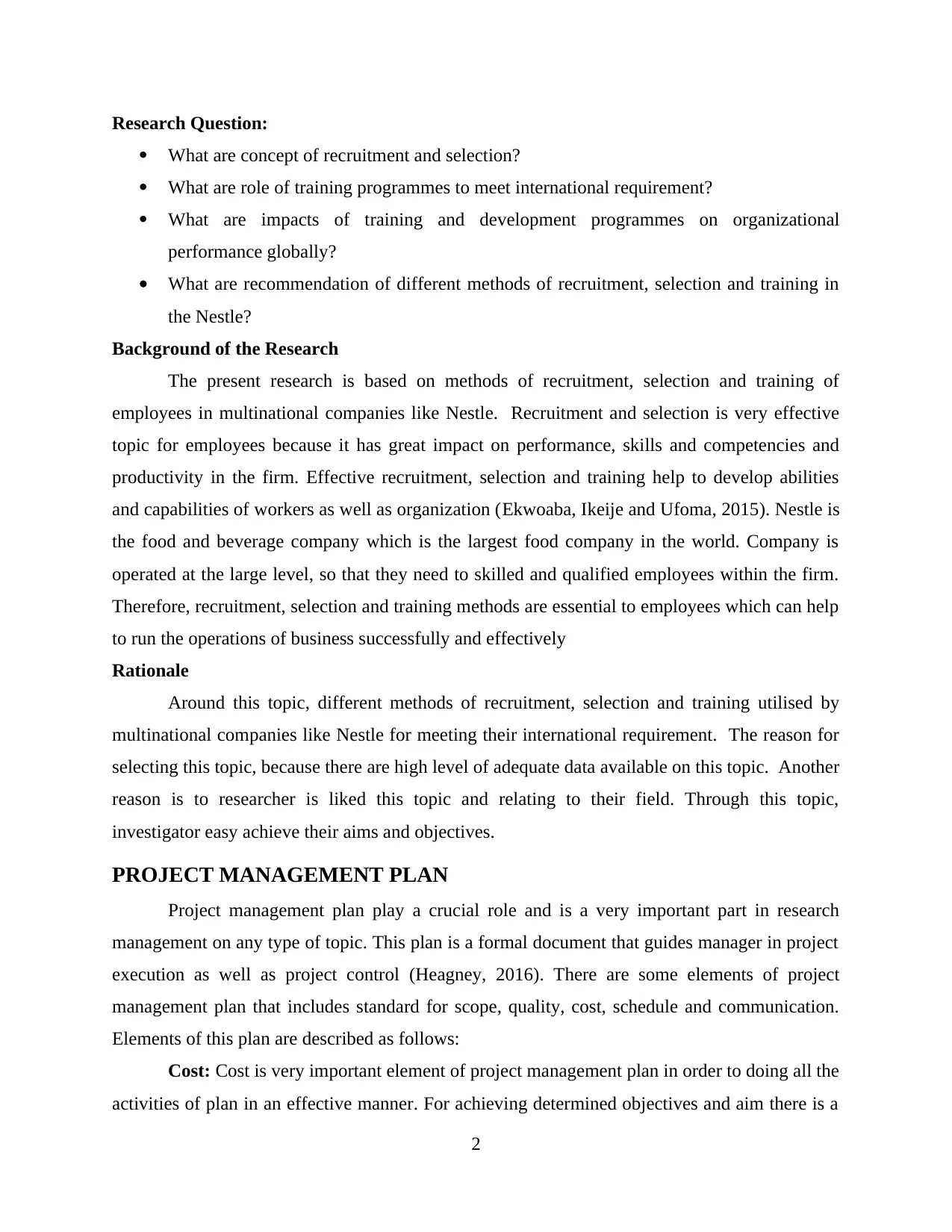
Research Question:
What are concept of recruitment and selection?
What are role of training programmes to meet international requirement?
What are impacts of training and development programmes on organizational
performance globally?
What are recommendation of different methods of recruitment, selection and training in
the Nestle?
Background of the Research
The present research is based on methods of recruitment, selection and training of
employees in multinational companies like Nestle. Recruitment and selection is very effective
topic for employees because it has great impact on performance, skills and competencies and
productivity in the firm. Effective recruitment, selection and training help to develop abilities
and capabilities of workers as well as organization (Ekwoaba, Ikeije and Ufoma, 2015). Nestle is
the food and beverage company which is the largest food company in the world. Company is
operated at the large level, so that they need to skilled and qualified employees within the firm.
Therefore, recruitment, selection and training methods are essential to employees which can help
to run the operations of business successfully and effectively
Rationale
Around this topic, different methods of recruitment, selection and training utilised by
multinational companies like Nestle for meeting their international requirement. The reason for
selecting this topic, because there are high level of adequate data available on this topic. Another
reason is to researcher is liked this topic and relating to their field. Through this topic,
investigator easy achieve their aims and objectives.
PROJECT MANAGEMENT PLAN
Project management plan play a crucial role and is a very important part in research
management on any type of topic. This plan is a formal document that guides manager in project
execution as well as project control (Heagney, 2016). There are some elements of project
management plan that includes standard for scope, quality, cost, schedule and communication.
Elements of this plan are described as follows:
Cost: Cost is very important element of project management plan in order to doing all the
activities of plan in an effective manner. For achieving determined objectives and aim there is a
2
What are concept of recruitment and selection?
What are role of training programmes to meet international requirement?
What are impacts of training and development programmes on organizational
performance globally?
What are recommendation of different methods of recruitment, selection and training in
the Nestle?
Background of the Research
The present research is based on methods of recruitment, selection and training of
employees in multinational companies like Nestle. Recruitment and selection is very effective
topic for employees because it has great impact on performance, skills and competencies and
productivity in the firm. Effective recruitment, selection and training help to develop abilities
and capabilities of workers as well as organization (Ekwoaba, Ikeije and Ufoma, 2015). Nestle is
the food and beverage company which is the largest food company in the world. Company is
operated at the large level, so that they need to skilled and qualified employees within the firm.
Therefore, recruitment, selection and training methods are essential to employees which can help
to run the operations of business successfully and effectively
Rationale
Around this topic, different methods of recruitment, selection and training utilised by
multinational companies like Nestle for meeting their international requirement. The reason for
selecting this topic, because there are high level of adequate data available on this topic. Another
reason is to researcher is liked this topic and relating to their field. Through this topic,
investigator easy achieve their aims and objectives.
PROJECT MANAGEMENT PLAN
Project management plan play a crucial role and is a very important part in research
management on any type of topic. This plan is a formal document that guides manager in project
execution as well as project control (Heagney, 2016). There are some elements of project
management plan that includes standard for scope, quality, cost, schedule and communication.
Elements of this plan are described as follows:
Cost: Cost is very important element of project management plan in order to doing all the
activities of plan in an effective manner. For achieving determined objectives and aim there is a
2
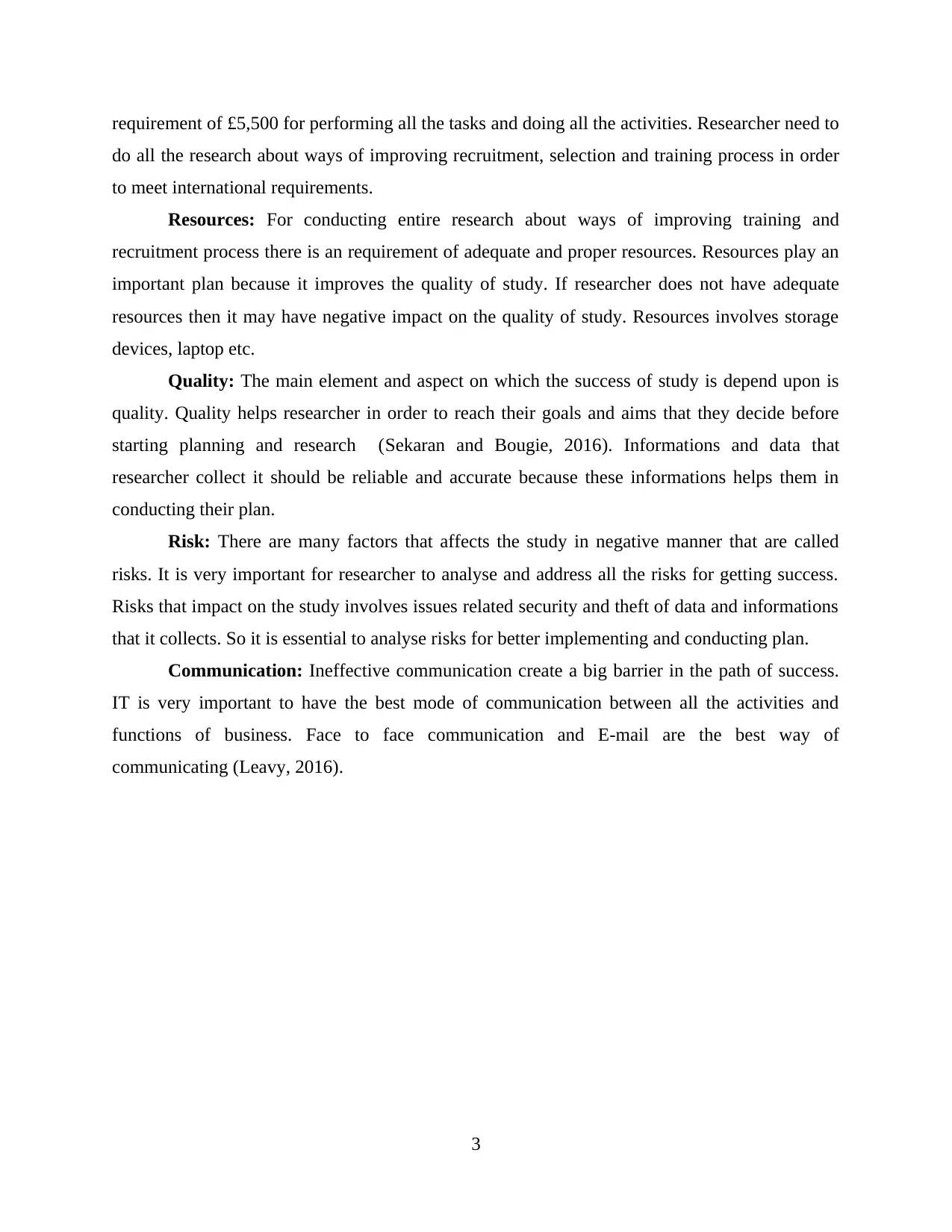
requirement of £5,500 for performing all the tasks and doing all the activities. Researcher need to
do all the research about ways of improving recruitment, selection and training process in order
to meet international requirements.
Resources: For conducting entire research about ways of improving training and
recruitment process there is an requirement of adequate and proper resources. Resources play an
important plan because it improves the quality of study. If researcher does not have adequate
resources then it may have negative impact on the quality of study. Resources involves storage
devices, laptop etc.
Quality: The main element and aspect on which the success of study is depend upon is
quality. Quality helps researcher in order to reach their goals and aims that they decide before
starting planning and research (Sekaran and Bougie, 2016). Informations and data that
researcher collect it should be reliable and accurate because these informations helps them in
conducting their plan.
Risk: There are many factors that affects the study in negative manner that are called
risks. It is very important for researcher to analyse and address all the risks for getting success.
Risks that impact on the study involves issues related security and theft of data and informations
that it collects. So it is essential to analyse risks for better implementing and conducting plan.
Communication: Ineffective communication create a big barrier in the path of success.
IT is very important to have the best mode of communication between all the activities and
functions of business. Face to face communication and E-mail are the best way of
communicating (Leavy, 2016).
3
do all the research about ways of improving recruitment, selection and training process in order
to meet international requirements.
Resources: For conducting entire research about ways of improving training and
recruitment process there is an requirement of adequate and proper resources. Resources play an
important plan because it improves the quality of study. If researcher does not have adequate
resources then it may have negative impact on the quality of study. Resources involves storage
devices, laptop etc.
Quality: The main element and aspect on which the success of study is depend upon is
quality. Quality helps researcher in order to reach their goals and aims that they decide before
starting planning and research (Sekaran and Bougie, 2016). Informations and data that
researcher collect it should be reliable and accurate because these informations helps them in
conducting their plan.
Risk: There are many factors that affects the study in negative manner that are called
risks. It is very important for researcher to analyse and address all the risks for getting success.
Risks that impact on the study involves issues related security and theft of data and informations
that it collects. So it is essential to analyse risks for better implementing and conducting plan.
Communication: Ineffective communication create a big barrier in the path of success.
IT is very important to have the best mode of communication between all the activities and
functions of business. Face to face communication and E-mail are the best way of
communicating (Leavy, 2016).
3
⊘ This is a preview!⊘
Do you want full access?
Subscribe today to unlock all pages.

Trusted by 1+ million students worldwide
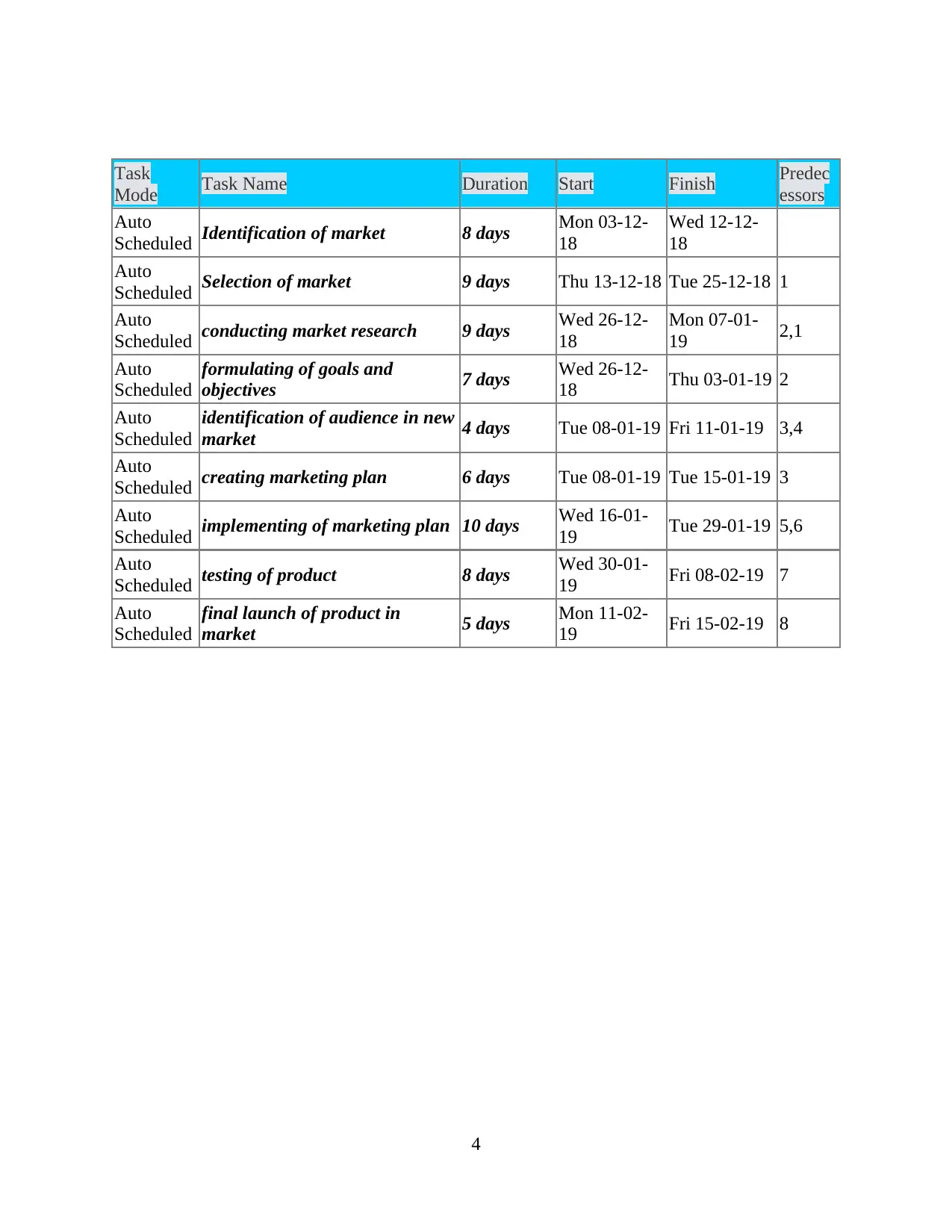
Task
Mode Task Name Duration Start Finish Predec
essors
Auto
Scheduled Identification of market 8 days Mon 03-12-
18
Wed 12-12-
18
Auto
Scheduled Selection of market 9 days Thu 13-12-18 Tue 25-12-18 1
Auto
Scheduled conducting market research 9 days Wed 26-12-
18
Mon 07-01-
19 2,1
Auto
Scheduled
formulating of goals and
objectives 7 days Wed 26-12-
18 Thu 03-01-19 2
Auto
Scheduled
identification of audience in new
market 4 days Tue 08-01-19 Fri 11-01-19 3,4
Auto
Scheduled creating marketing plan 6 days Tue 08-01-19 Tue 15-01-19 3
Auto
Scheduled implementing of marketing plan 10 days Wed 16-01-
19 Tue 29-01-19 5,6
Auto
Scheduled testing of product 8 days Wed 30-01-
19 Fri 08-02-19 7
Auto
Scheduled
final launch of product in
market 5 days Mon 11-02-
19 Fri 15-02-19 8
4
Mode Task Name Duration Start Finish Predec
essors
Auto
Scheduled Identification of market 8 days Mon 03-12-
18
Wed 12-12-
18
Auto
Scheduled Selection of market 9 days Thu 13-12-18 Tue 25-12-18 1
Auto
Scheduled conducting market research 9 days Wed 26-12-
18
Mon 07-01-
19 2,1
Auto
Scheduled
formulating of goals and
objectives 7 days Wed 26-12-
18 Thu 03-01-19 2
Auto
Scheduled
identification of audience in new
market 4 days Tue 08-01-19 Fri 11-01-19 3,4
Auto
Scheduled creating marketing plan 6 days Tue 08-01-19 Tue 15-01-19 3
Auto
Scheduled implementing of marketing plan 10 days Wed 16-01-
19 Tue 29-01-19 5,6
Auto
Scheduled testing of product 8 days Wed 30-01-
19 Fri 08-02-19 7
Auto
Scheduled
final launch of product in
market 5 days Mon 11-02-
19 Fri 15-02-19 8
4
Paraphrase This Document
Need a fresh take? Get an instant paraphrase of this document with our AI Paraphraser
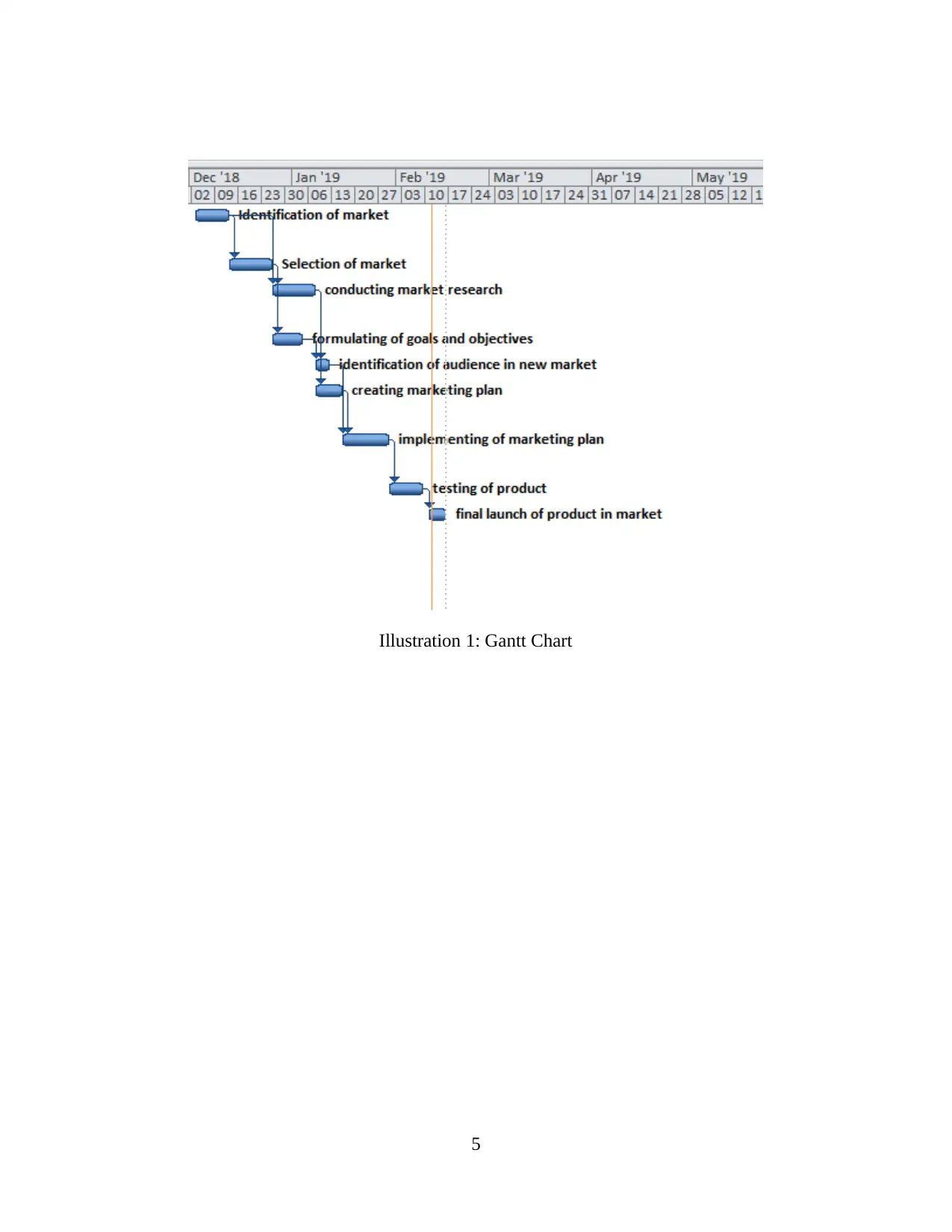
Illustration 1: Gantt Chart
5
5
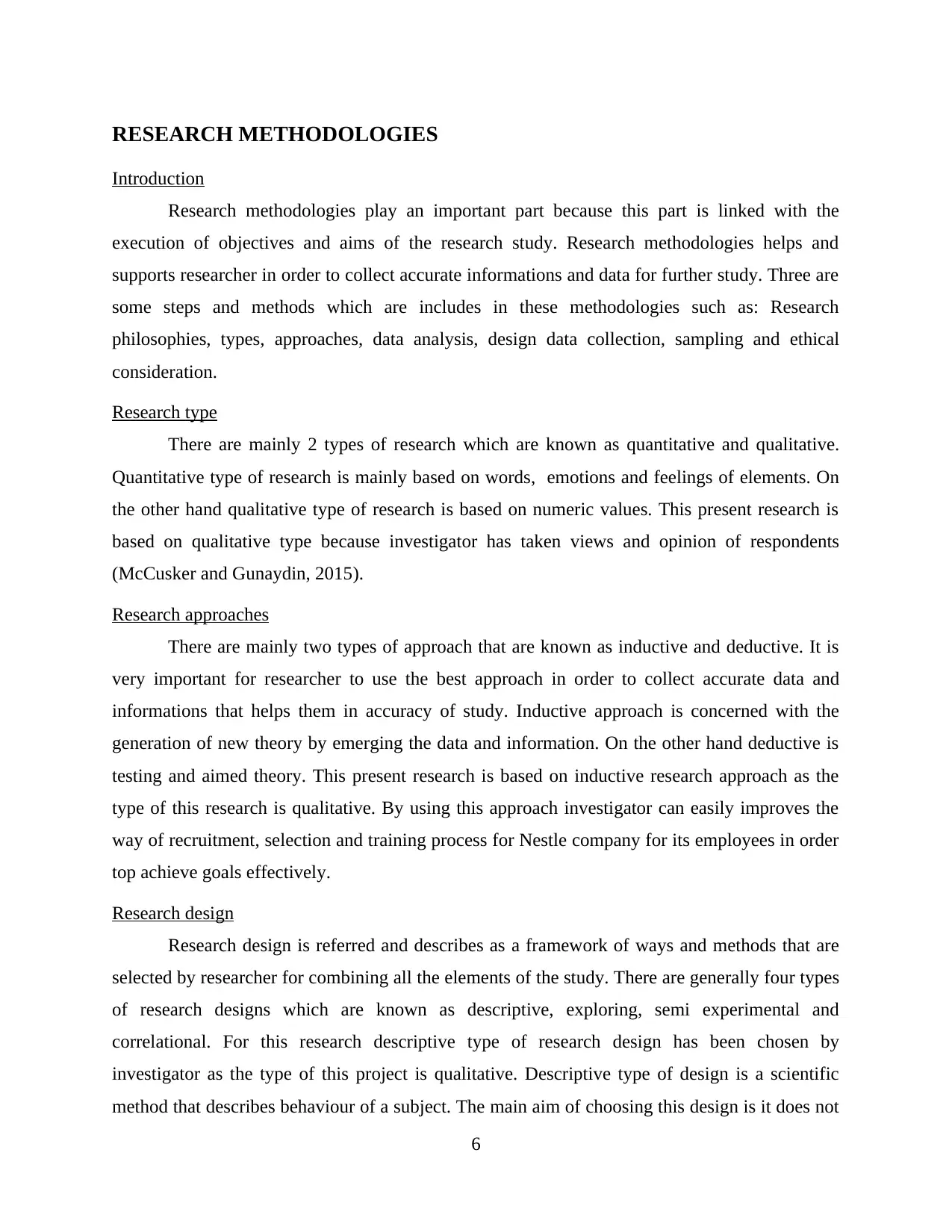
RESEARCH METHODOLOGIES
Introduction
Research methodologies play an important part because this part is linked with the
execution of objectives and aims of the research study. Research methodologies helps and
supports researcher in order to collect accurate informations and data for further study. Three are
some steps and methods which are includes in these methodologies such as: Research
philosophies, types, approaches, data analysis, design data collection, sampling and ethical
consideration.
Research type
There are mainly 2 types of research which are known as quantitative and qualitative.
Quantitative type of research is mainly based on words, emotions and feelings of elements. On
the other hand qualitative type of research is based on numeric values. This present research is
based on qualitative type because investigator has taken views and opinion of respondents
(McCusker and Gunaydin, 2015).
Research approaches
There are mainly two types of approach that are known as inductive and deductive. It is
very important for researcher to use the best approach in order to collect accurate data and
informations that helps them in accuracy of study. Inductive approach is concerned with the
generation of new theory by emerging the data and information. On the other hand deductive is
testing and aimed theory. This present research is based on inductive research approach as the
type of this research is qualitative. By using this approach investigator can easily improves the
way of recruitment, selection and training process for Nestle company for its employees in order
top achieve goals effectively.
Research design
Research design is referred and describes as a framework of ways and methods that are
selected by researcher for combining all the elements of the study. There are generally four types
of research designs which are known as descriptive, exploring, semi experimental and
correlational. For this research descriptive type of research design has been chosen by
investigator as the type of this project is qualitative. Descriptive type of design is a scientific
method that describes behaviour of a subject. The main aim of choosing this design is it does not
6
Introduction
Research methodologies play an important part because this part is linked with the
execution of objectives and aims of the research study. Research methodologies helps and
supports researcher in order to collect accurate informations and data for further study. Three are
some steps and methods which are includes in these methodologies such as: Research
philosophies, types, approaches, data analysis, design data collection, sampling and ethical
consideration.
Research type
There are mainly 2 types of research which are known as quantitative and qualitative.
Quantitative type of research is mainly based on words, emotions and feelings of elements. On
the other hand qualitative type of research is based on numeric values. This present research is
based on qualitative type because investigator has taken views and opinion of respondents
(McCusker and Gunaydin, 2015).
Research approaches
There are mainly two types of approach that are known as inductive and deductive. It is
very important for researcher to use the best approach in order to collect accurate data and
informations that helps them in accuracy of study. Inductive approach is concerned with the
generation of new theory by emerging the data and information. On the other hand deductive is
testing and aimed theory. This present research is based on inductive research approach as the
type of this research is qualitative. By using this approach investigator can easily improves the
way of recruitment, selection and training process for Nestle company for its employees in order
top achieve goals effectively.
Research design
Research design is referred and describes as a framework of ways and methods that are
selected by researcher for combining all the elements of the study. There are generally four types
of research designs which are known as descriptive, exploring, semi experimental and
correlational. For this research descriptive type of research design has been chosen by
investigator as the type of this project is qualitative. Descriptive type of design is a scientific
method that describes behaviour of a subject. The main aim of choosing this design is it does not
6
⊘ This is a preview!⊘
Do you want full access?
Subscribe today to unlock all pages.

Trusted by 1+ million students worldwide
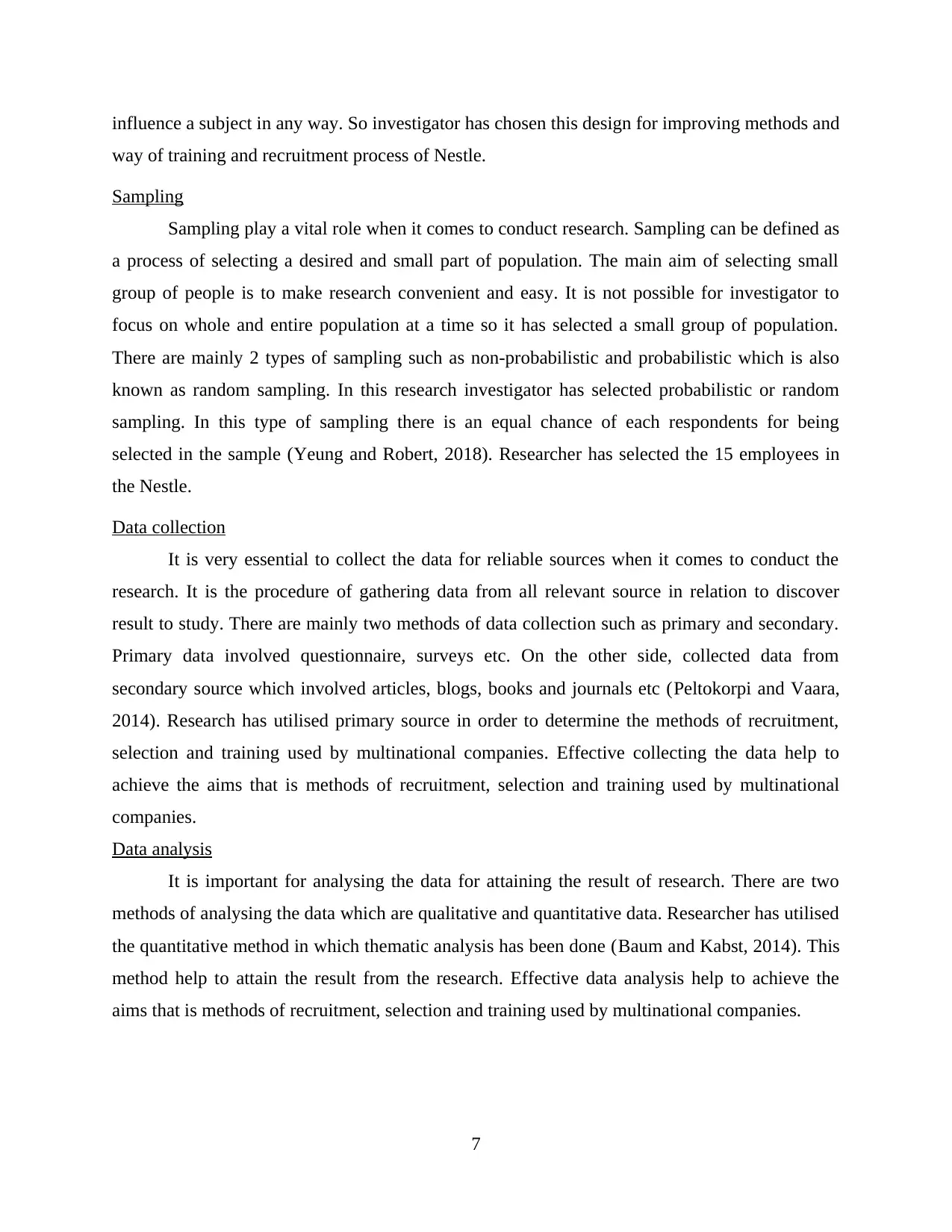
influence a subject in any way. So investigator has chosen this design for improving methods and
way of training and recruitment process of Nestle.
Sampling
Sampling play a vital role when it comes to conduct research. Sampling can be defined as
a process of selecting a desired and small part of population. The main aim of selecting small
group of people is to make research convenient and easy. It is not possible for investigator to
focus on whole and entire population at a time so it has selected a small group of population.
There are mainly 2 types of sampling such as non-probabilistic and probabilistic which is also
known as random sampling. In this research investigator has selected probabilistic or random
sampling. In this type of sampling there is an equal chance of each respondents for being
selected in the sample (Yeung and Robert, 2018). Researcher has selected the 15 employees in
the Nestle.
Data collection
It is very essential to collect the data for reliable sources when it comes to conduct the
research. It is the procedure of gathering data from all relevant source in relation to discover
result to study. There are mainly two methods of data collection such as primary and secondary.
Primary data involved questionnaire, surveys etc. On the other side, collected data from
secondary source which involved articles, blogs, books and journals etc (Peltokorpi and Vaara,
2014). Research has utilised primary source in order to determine the methods of recruitment,
selection and training used by multinational companies. Effective collecting the data help to
achieve the aims that is methods of recruitment, selection and training used by multinational
companies.
Data analysis
It is important for analysing the data for attaining the result of research. There are two
methods of analysing the data which are qualitative and quantitative data. Researcher has utilised
the quantitative method in which thematic analysis has been done (Baum and Kabst, 2014). This
method help to attain the result from the research. Effective data analysis help to achieve the
aims that is methods of recruitment, selection and training used by multinational companies.
7
way of training and recruitment process of Nestle.
Sampling
Sampling play a vital role when it comes to conduct research. Sampling can be defined as
a process of selecting a desired and small part of population. The main aim of selecting small
group of people is to make research convenient and easy. It is not possible for investigator to
focus on whole and entire population at a time so it has selected a small group of population.
There are mainly 2 types of sampling such as non-probabilistic and probabilistic which is also
known as random sampling. In this research investigator has selected probabilistic or random
sampling. In this type of sampling there is an equal chance of each respondents for being
selected in the sample (Yeung and Robert, 2018). Researcher has selected the 15 employees in
the Nestle.
Data collection
It is very essential to collect the data for reliable sources when it comes to conduct the
research. It is the procedure of gathering data from all relevant source in relation to discover
result to study. There are mainly two methods of data collection such as primary and secondary.
Primary data involved questionnaire, surveys etc. On the other side, collected data from
secondary source which involved articles, blogs, books and journals etc (Peltokorpi and Vaara,
2014). Research has utilised primary source in order to determine the methods of recruitment,
selection and training used by multinational companies. Effective collecting the data help to
achieve the aims that is methods of recruitment, selection and training used by multinational
companies.
Data analysis
It is important for analysing the data for attaining the result of research. There are two
methods of analysing the data which are qualitative and quantitative data. Researcher has utilised
the quantitative method in which thematic analysis has been done (Baum and Kabst, 2014). This
method help to attain the result from the research. Effective data analysis help to achieve the
aims that is methods of recruitment, selection and training used by multinational companies.
7
Paraphrase This Document
Need a fresh take? Get an instant paraphrase of this document with our AI Paraphraser
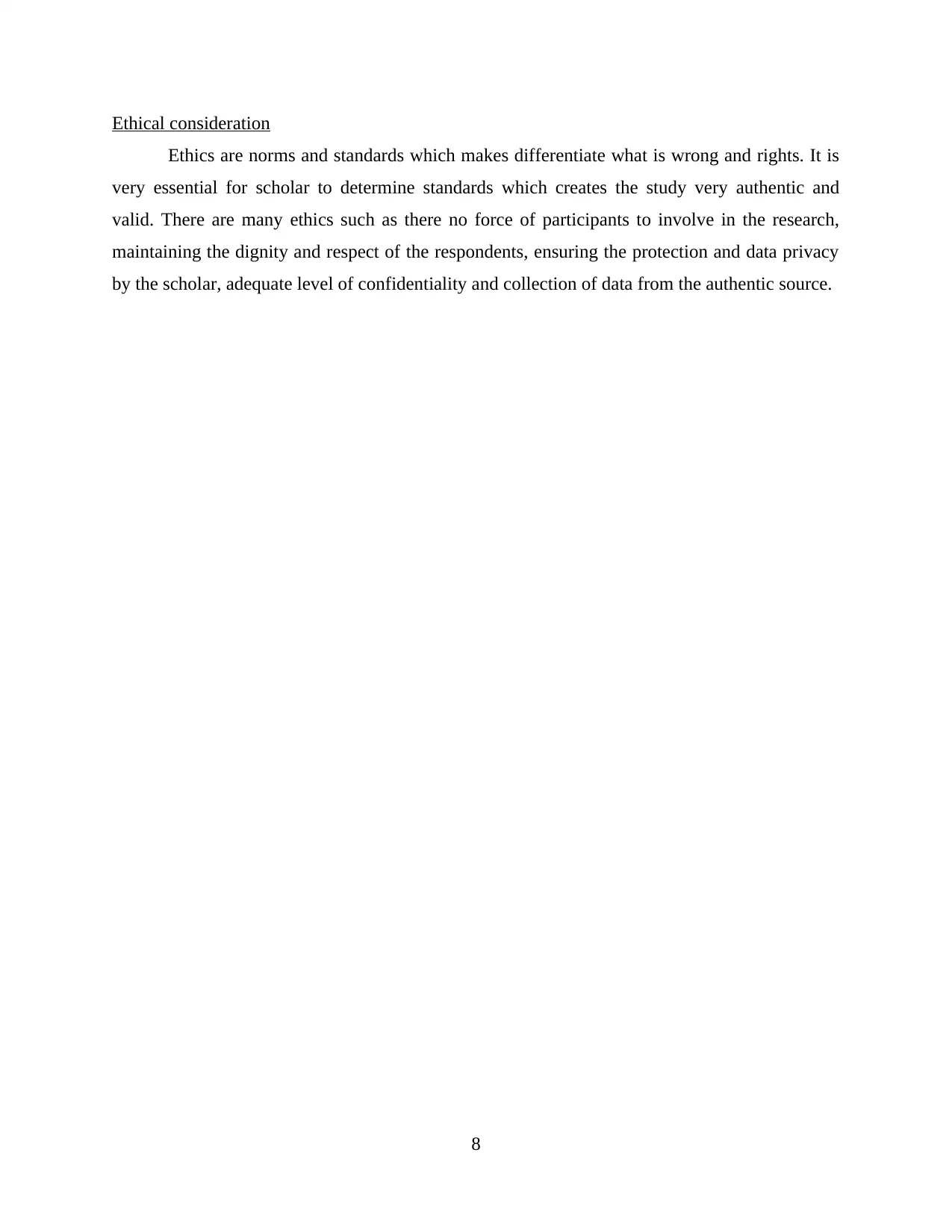
Ethical consideration
Ethics are norms and standards which makes differentiate what is wrong and rights. It is
very essential for scholar to determine standards which creates the study very authentic and
valid. There are many ethics such as there no force of participants to involve in the research,
maintaining the dignity and respect of the respondents, ensuring the protection and data privacy
by the scholar, adequate level of confidentiality and collection of data from the authentic source.
8
Ethics are norms and standards which makes differentiate what is wrong and rights. It is
very essential for scholar to determine standards which creates the study very authentic and
valid. There are many ethics such as there no force of participants to involve in the research,
maintaining the dignity and respect of the respondents, ensuring the protection and data privacy
by the scholar, adequate level of confidentiality and collection of data from the authentic source.
8
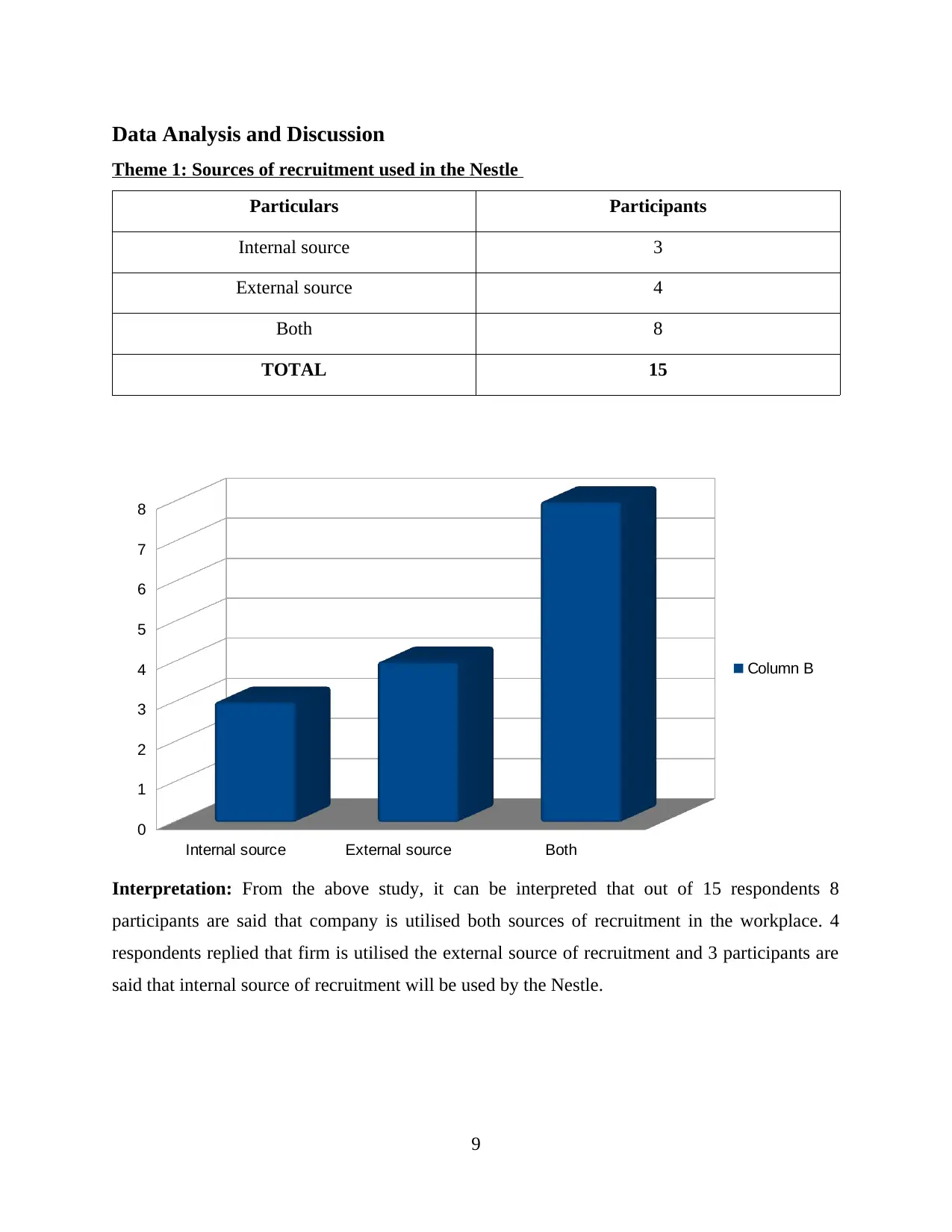
Data Analysis and Discussion
Theme 1: Sources of recruitment used in the Nestle
Particulars Participants
Internal source 3
External source 4
Both 8
TOTAL 15
Interpretation: From the above study, it can be interpreted that out of 15 respondents 8
participants are said that company is utilised both sources of recruitment in the workplace. 4
respondents replied that firm is utilised the external source of recruitment and 3 participants are
said that internal source of recruitment will be used by the Nestle.
9
Internal source External source Both
0
1
2
3
4
5
6
7
8
Column B
Theme 1: Sources of recruitment used in the Nestle
Particulars Participants
Internal source 3
External source 4
Both 8
TOTAL 15
Interpretation: From the above study, it can be interpreted that out of 15 respondents 8
participants are said that company is utilised both sources of recruitment in the workplace. 4
respondents replied that firm is utilised the external source of recruitment and 3 participants are
said that internal source of recruitment will be used by the Nestle.
9
Internal source External source Both
0
1
2
3
4
5
6
7
8
Column B
⊘ This is a preview!⊘
Do you want full access?
Subscribe today to unlock all pages.

Trusted by 1+ million students worldwide
1 out of 24
Related Documents
Your All-in-One AI-Powered Toolkit for Academic Success.
+13062052269
info@desklib.com
Available 24*7 on WhatsApp / Email
![[object Object]](/_next/static/media/star-bottom.7253800d.svg)
Unlock your academic potential
Copyright © 2020–2025 A2Z Services. All Rights Reserved. Developed and managed by ZUCOL.





